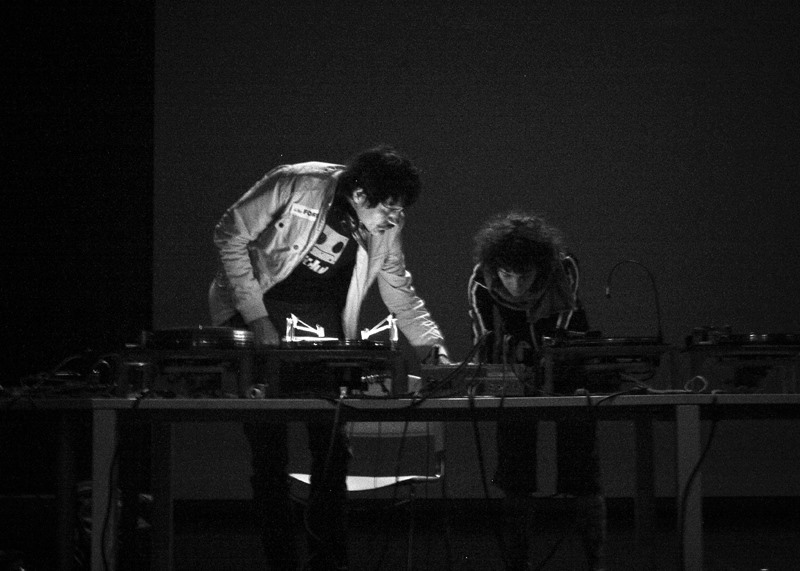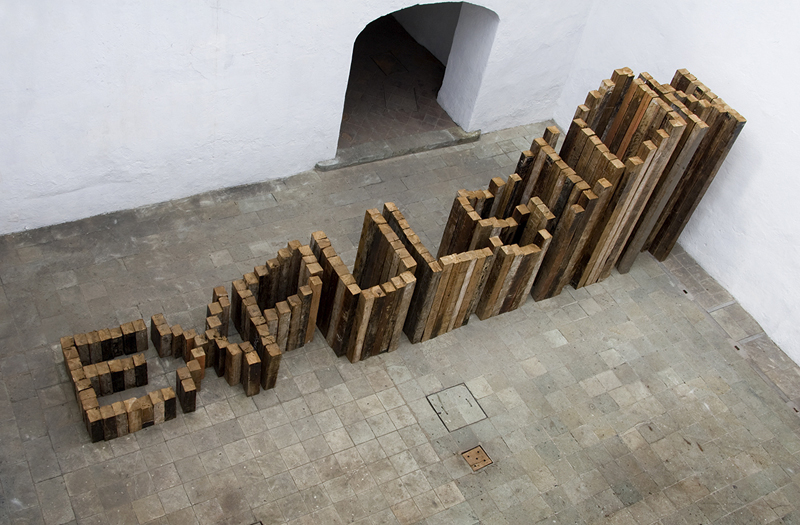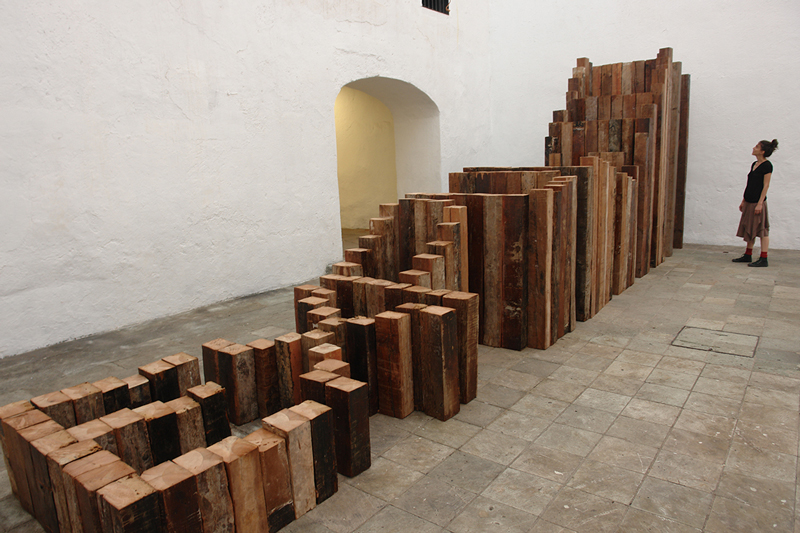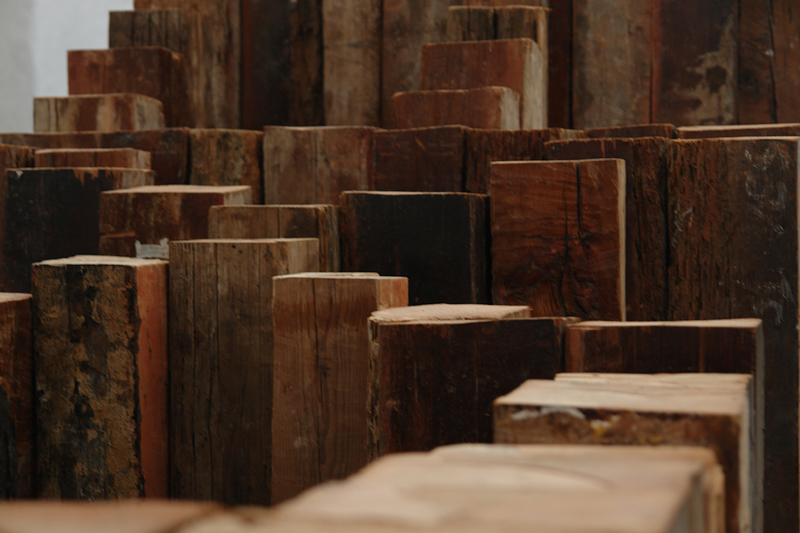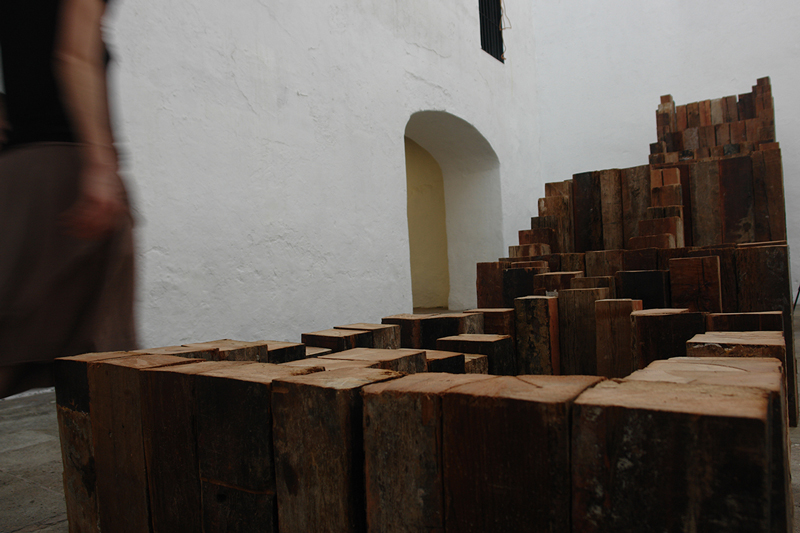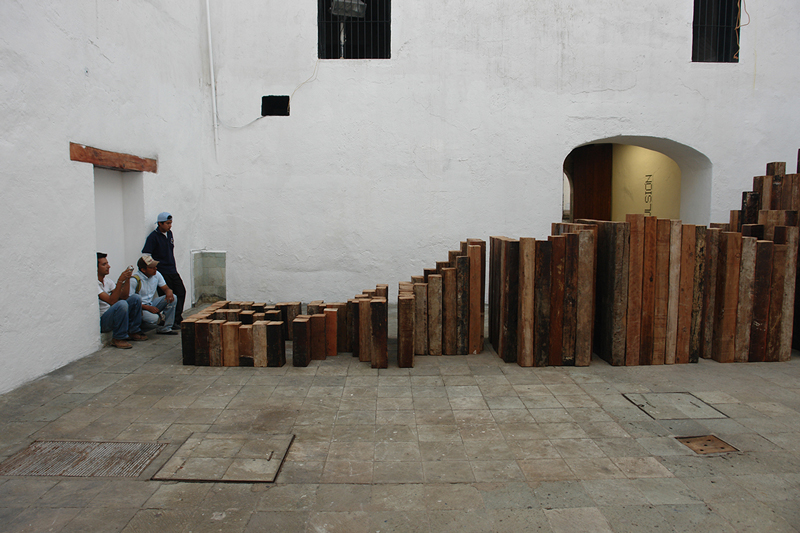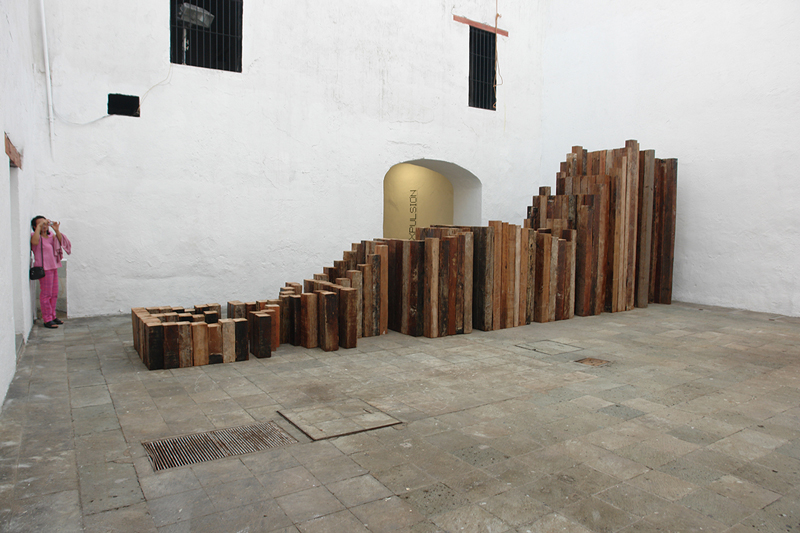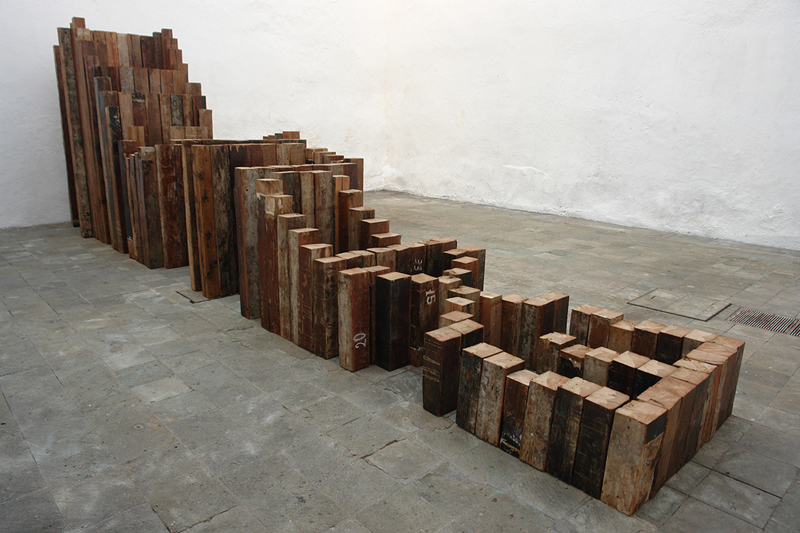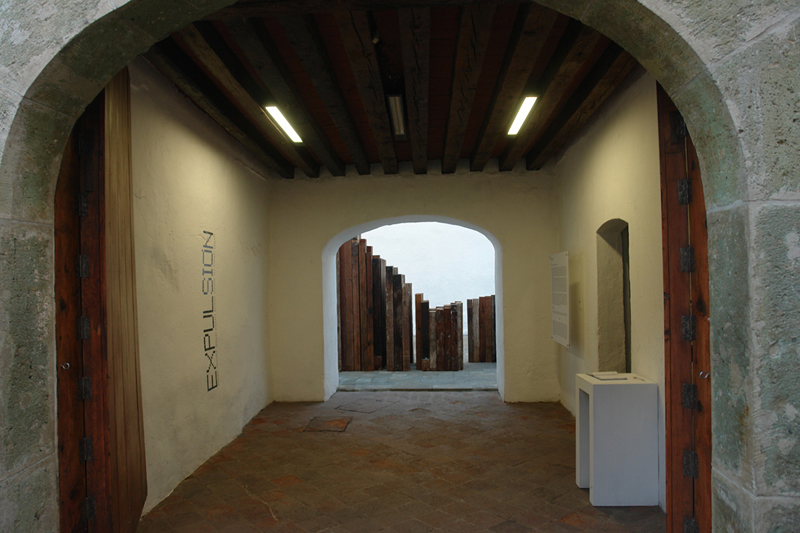Projects in Collaboration
SIDERAL
2016-2020
Gilberto Esparza y Marcela Armas en colaboración con Daniel Llermaly y Diego Liedo
Sideral es un proyecto basado en el desarrollo de instrumentos que generan sonido a partir de la detección de campos magnéticos de meteoritos que han caído sobre la Tierra.
Nuestro objetivo no es la mera sonificación de datos, sino la exploración de las posibilidades de la tecnología -software, electrónica, mecánica- como vehículo para recuperar nuestro vínculo con la naturaleza y los sujetos no humanos que la componen.
Diseñamos un instrumento único para cada meteorito. Cada uno de ellos tiene un conjunto de sensores que en tiempo real arrojan datos de intensidades magnéticas que se encuentran en la superficie de los meteoritos. Estos datos interactúan con las composiciones sonoras provocando variaciones de diferentes parámetros, como la espacialización, el tono del sonido, el ritmo y la frecuencia. Esto permite que las composiciones abiertas sean ejecutadas por meteoritos a través de sus campos magnéticos. La experiencia de sonido resultante está inspirada en los sitios y la historia donde ha impactado cada meteorito.
Algunas de las comunidades locales cercanas a los cráteres han creado un imaginario colectivo singular y una identidad asociada con estos cuerpos celestes. En ese sentido, el magnetismo como memoria mineral se entiende como alma. Buscamos establecer encuentros humano-mineral y espacios abiertos para la contemplación mediada por el sonido.
Nos interesa repensar la distinción entre sociedad y naturaleza, entre alma y cuerpo. Ampliar simbólicamente la presencia de lo espiritual que es material y corpóreo (Boaventura de Sousa Santos).
—
Sideral is a project based on the development of instruments that generate sound from the detection of magnetic fields of meteorites that have fallen on Earth.
Our goal is not the mere sonification of data, but the exploration of the possibilities of technology -software, electronics, mechanics- as a vehicle to regain our link with nature and the non-human subjects that comprise it.
We design a unique instrument for each meteorite. Each of them has a set of sensors that in real-time throw data of magnetic intensities found at the surface of the meteorites. These data interact with sound compositions provoking variations of different parameters, such as spatialization, the pitch of the sound, rhythm, and frequency. This lets open compositions be executed by meteorites through their magnetic fields. The resulting sound experience is inspired by the sites and history where each meteorite has impacted.
Some of the local communities near the craters have created a collective singular imaginary and identity associated with these heavenly bodies. In that sense, magnetism as a mineral memory is understood as a soul. We seek to establish human-mineral encounters and open spaces for contemplation mediated by sound.
We are interested in rethinking the distinction between society and nature, between soul and body. Symbolically amplify the presence of the spiritual that is material and corporeal (Boaventura de Sousa Santos).
Museo Ex Teresa Arte Actual – August 26th – October 23th, 2016.
Kunstraum Kreuzberg, Berlin – November 25th, 2016 – January, 2017
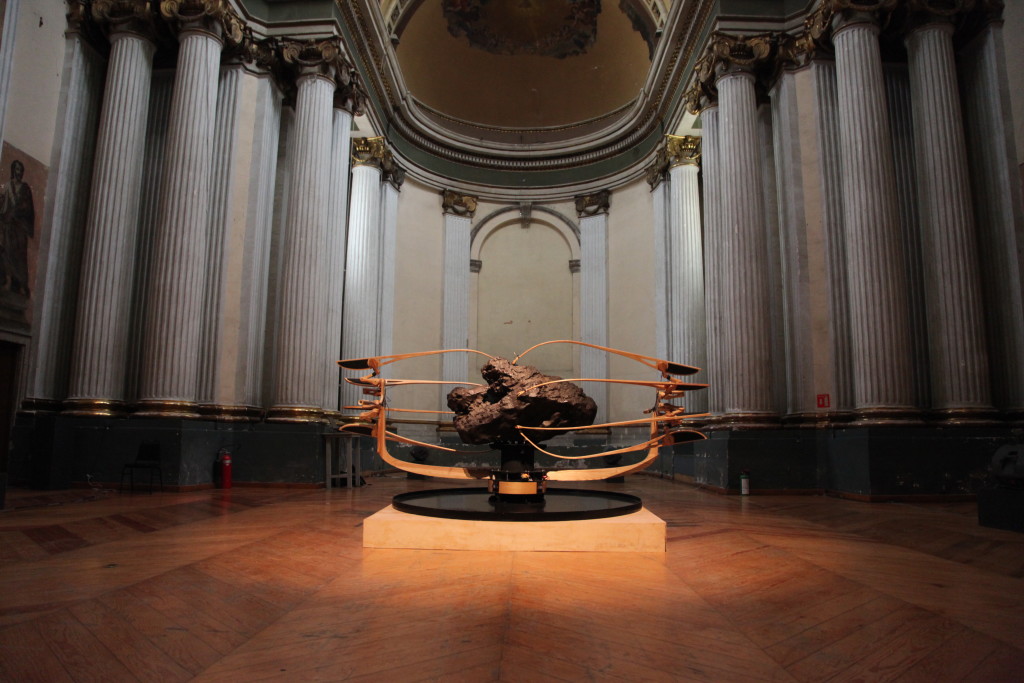
Sideral – La Concepción o Adargas, 3.3 tons. Photography by Gilberto Esparza
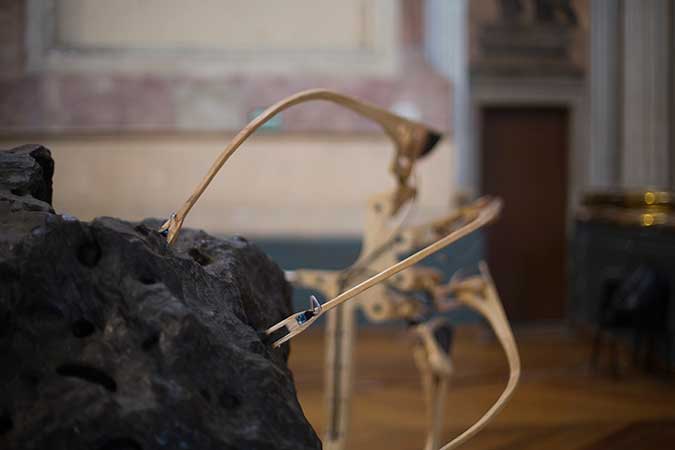
Sideral – La Concepción o Adargas, 3.3 tons. Photography by Gudinni Cortina
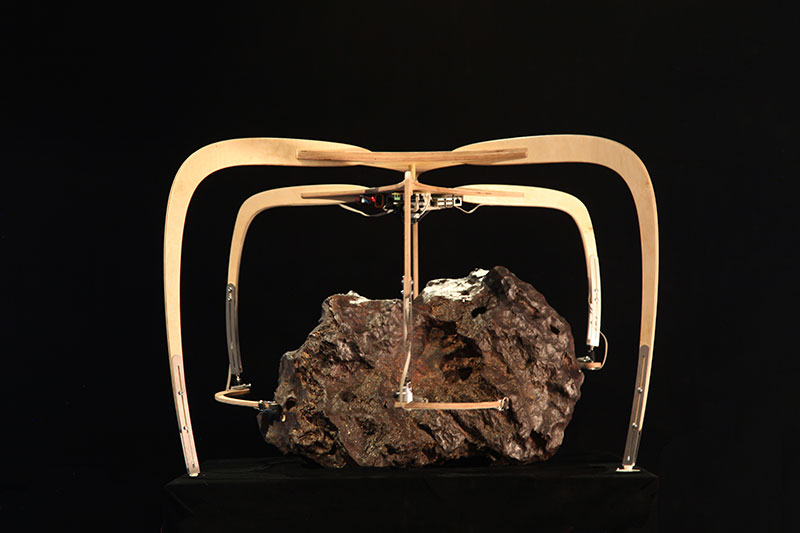
Sideral – 286 kg. Meteorite at Archenhold Observatory, Berlin.
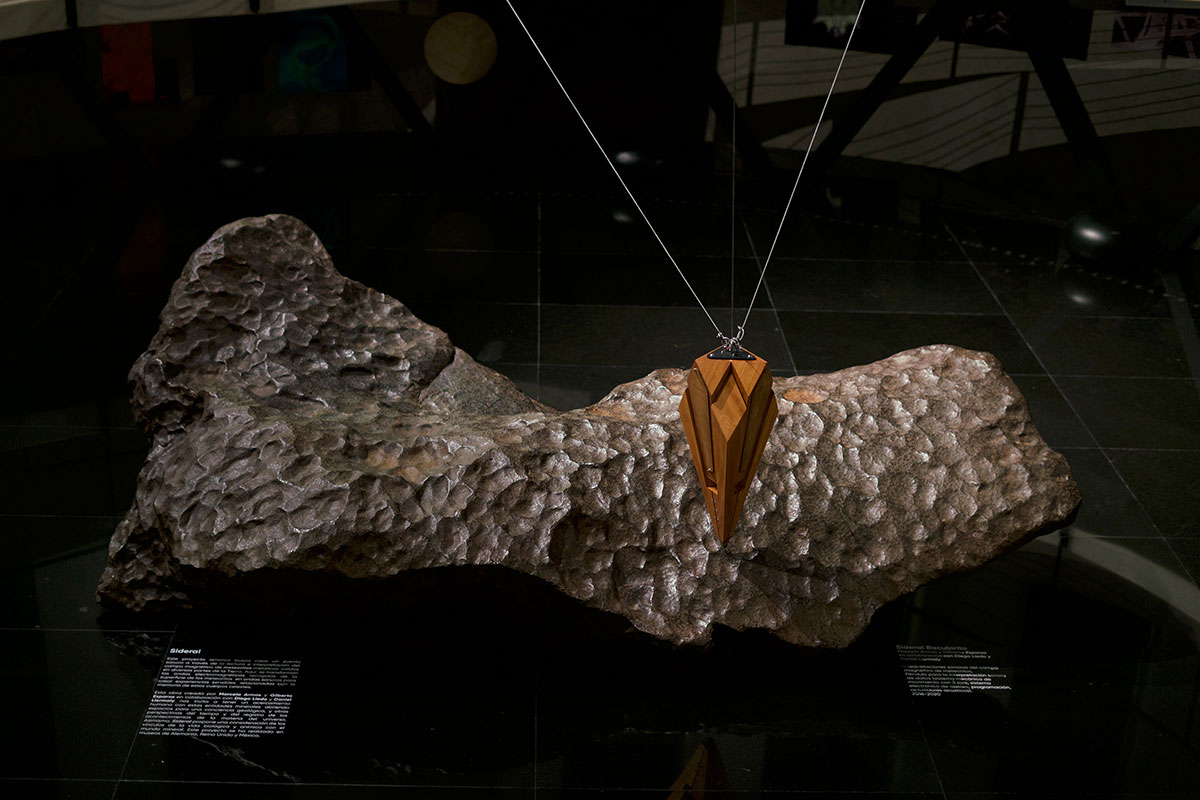 Sideral – Bacubirito, 21 tons. Photography by Gilberto Esparza
Sideral – Bacubirito, 21 tons. Photography by Gilberto Esparza
Credits:
Marcela Armas y Gilberto Esparza
En colaboración con Daniel Llermaly y Diego Liedo.
Con el apoyo de Ex Teresa Arte Actual – INBA / Goethe-Institut Mexiko, Instituto de Astronomía y Dirección General de Divulgación de la Ciencia de la UNAM, Natural History Museum of London.
Museo Materia del Centro de las Ciencias de Sinaloa.
Para la exhibición Entre Límites, Zwischen Grenzen. Espacios Sonoros en México y Alemania / Klangraüme in Mexiko und Deutshland. Carsten Seiffarth, curador.
Festival Sonica – Glasgow, UK. Caty Boyd, curadora.
Versos del Cosmos. Curaduría de KOSMICA Institute en México: Manuel Díaz, Mariana Paredes, Nahum
Agradecemos a: Rodrigo Escobedo Baena, Tito Rivas, Emilio Converso, Pedro Ortiz Antoráz, Iván Edeza, Julián Monroy, Santiago Itzcóatl, Daniel Flores (Instituto de Astronomía UNAM)
Taiyo Miyake, Bruno Monsiváis, Carlos Chinchillas Terrazas – producción
Salvador Chávez – programación
Dedicado a Turi Banhí quien nació con este proyecto.
GIROTRONIC
2008
GILMAR
Marcela Armas + Gilberto Esparza
Girotronic es un acto sonoro en vivo realizado con cuatro tornamesas modificadas con electrónica análoga: interruptores, sensores de luz, osciladores de audio, variaciones de voltaje, radios intervenidos, micrófonos de contacto. La obra se basa en el diseño y la construcción de discos electrónicos de cobre y acrílico como piezas únicas que son interpretadas bajo un principio de improvisación libre dentro de una estructura temporal de 33 rpm. Cada disco tiene cualidades específicas que definen su naturaleza sonora, a partir de dibujos, mapas, textos que funcionan como líneas de transmisión de voltaje.
Se trata de una experiencia sonora que corresponde a la acción física inmediata: la corriente eléctrica manipulada a través de luz, vibraciones e interrupciones.
—
Girotronic is a sound live act performed with four turntables modified with analog electronics: switches, light sensors, audio oscillators, voltage variations, radios, contact microphones. The play is based on the design and construction of electronic records such as copper and acrylic unique pieces that are performed under a principle of free improvisation within a temporal structure of 33 rpm. Each disk has specific qualities that define its natural sound, from drawings, maps, texts that function as voltage transmission lines.
This is a sound experience that corresponds to the immediate physical action: the electric power manipulated by light, vibration, and disruption.
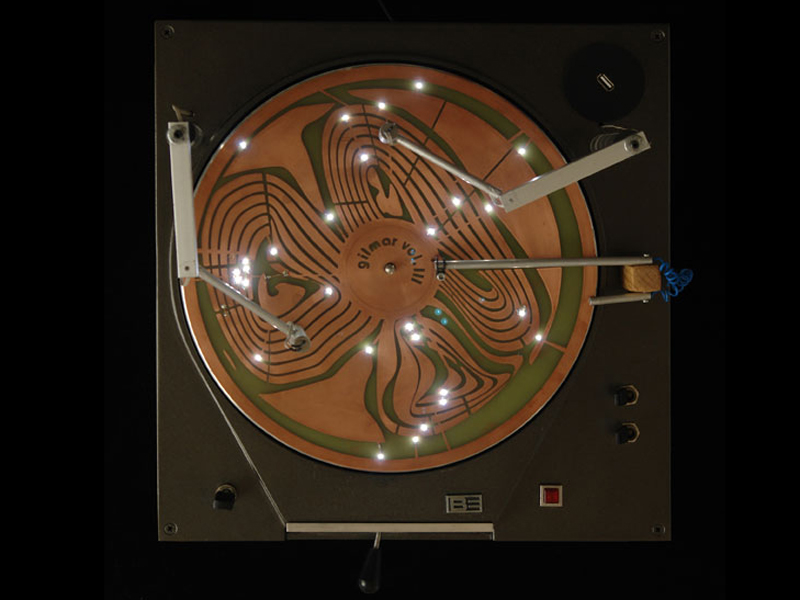
BREATH
Gilmar, 2010
EXPULSION
TRiodO, 2009
Intervención específica in situ
Madera recuperada de la remodelación del Museo de Arte Contemporáneo de Oaxaca MACO
Desde el inicio de este proyecto, nos interesó la recuperación de algunos de los materiales de desecho provenientes del proceso de remodelación del Museo de Arte Contemporáneo de Oaxaca. El propósito de ubicar una intervención de sitio específico dentro de este proceso de restauración arquitectónica, fue una idea muy sugerente, en términos de una inserción concreta y simbólica de la obra en la dinámica reconstructiva.
Elegimos las vigas de madera de desecho, considerando su significado como soporte estructural funcional y también sus posibilidades escultóricas y arquitectónicas. El objetivo de dar un nuevo uso constructivo a estos elementos se convirtió en el punto de partida para abordar el fenómeno migratorio mexicano en el caso específico del estado de Oaxaca en México.
La obra propone utilizar parte de las vigas reemplazadas del edificio, para construir un gráfico tridimensional de análisis estadístico sobre los niveles de migración que ha experimentado la población *, mayoritariamente indígena de Oaxaca, desde 1950 hasta 2009. Proponemos la construcción física de el gráfico, como materialización simbólica del dominio de la estadística en la sociedad. La idea es enfocar el significado y rol que adquiere la información frente a la realidad de los fenómenos sociales y el problema específico que apuntamos.
La visualización material de datos en el sitio se revela como una característica morfológica de la palabra EXPULSION que se puede leer y experimentar en el espacio real. La palabra grande y las estadísticas se encuentran en dirección norte en el patio del Museo.
TRiodO
Noviembre de 2009
* Fuente de estadísticas:
Dirección General de Población de Oaxaca, DIGEPO.
Instituto Nacional de Estadística, Geografía e Información, INEGI.
Consejo Nacional de Población, CONAPO.
TRIODO
TRiodO es un colectivo formado por Marcela Armas, Gilberto Esparza e Iván Puig.
Desde hace más de 10 años colaboran en sus procesos individuales. Se conocieron durante sus estudios profesionales en la Universidad de Guanajuato en 1997. A partir de entonces, trabajan muy de cerca.
Desde entonces, a menudo han compartido procesos, viajes y juegos, experimentación y la formación de sus lenguajes personales.
Comparten preocupaciones sobre temas políticos, el uso de la tecnología y sus implicaciones sociales, el uso de materiales recuperados como punto de partida y posición crítica.
Los miembros de TRiodO, han exhibido su trabajo individualmente y como grupo en México y en el exterior.
—
TRiodO, 2009
Site-specific intervention
Recovered wood of the renovation of Museo de Arte Contemporáneo de Oaxaca MACO
Since the beginning of this project, we were interested in the recovery of some of the waste materials that came from the remodeling process of the Contemporary Art Museum of Oaxaca. The purpose to locate a site-specific intervention within this architectural restoration process, was a very suggestive idea, in terms of a concrete and symbolic insertion of the work into the reconstructive dynamics.
We chose the scrap wood beams, considering their meaning such as functioning structural support and also their sculptural and architectural possibilities. The aim of giving a new constructive use to these elements became the starting point for addressing the Mexican migration phenomenon in the specific case of Oaxaca State in Mexico.
The work proposes to use part of the replaced beams from the building, to construct a three-dimensional graphic of statistical analysis about migration levels that population*, -mostly indigenous of Oaxaca- has experienced from 1950 until 2009. We propose the physical construction of the graphic, as a symbolic materialization of the statistics domination in society. The idea is to focus on the meaning and role that acquires information in front of the reality of the social phenomena and the specific problem we noted.
The material display of data in the site is revealed as a morphological feature of the word EXPULSION that can be read and experienced in real space. The big word and statistics are located towards the North direction in the courtyard of the Museum.
TRiodO
November 2009
*Statistics source:
Dirección General de Población de Oaxaca, DIGEPO.
Instituto Nacional de Estadística,Geografía e Información, INEGI.
Consejo Nacional de Población, CONAPO.
TRIODO
TRiodO is a collective formed by Marcela Armas, Gilberto Esparza and Iván Puig.
For more than 10 years have been collaborating in their individual processes. They met during their professional studies at the University of Guanajuato in 1997. From then, they work very close
Since then, they often have shared processes, travel and gaming, experimentation, and the formation of their personal languages
They share concerns about political issues, the use of technology and its social implications, the use of recovered materials as a starting point, and critical position.
Members from TRiodO, have exhibited their work individually and as a group in Mexico and abroad.
MEDITATIO SONUS
MEDITATĬO SONUS es un ciclo de arte sonoro que propone meditaciones guiadas por el sonido y propone el mindfulness a través de la práctica de la escucha profunda. Encargamos a los artistas sonoros que investiguen la relación entre la mente, el sonido y la tecnología para que guíen las sesiones de meditación interpretando obras sonoras en vivo producidas específicamente para este ciclo. Meditatio Sonus es un espacio de investigación sobre el fenómeno del sonido y la percepción, que une el ejercicio de la escucha y la práctica de la meditación. Un proyecto inclusivo que busca la integración de públicos amplios y diversos y la conciencia de la sociedad en torno a la necesidad de integrar la experiencia colectiva del arte como medio de autoconocimiento. Apelamos a la capacidad del sonido como fenómeno físico y como lenguaje puro, que crea vínculos directos con la naturaleza del yo y el entorno en el que está inmerso y del que forma parte.
Meditatio Sonus cumple 10 años en los que hemos realizado 11 ciclos, un simposio y dos eventos especiales que han apoyado la Fundación Alumnos47, el Museo de Arte Contemporáneo de Oaxaca y el Centro Cultural Los Pinos en el Bosque de Chapultepec, con más de 80 artistas quienes han realizado acciones sonoras dominicales en vivo, utilizando lenguajes híbridos entre instrumentos acústicos, objetos sonoros, tecnologías análogas y digitales como sintetizadores electrónicos, hardware y software libre, dispositivos DIY, acciones performativas y un sinfín de recursos buscando crear entornos propicios para experimentar la escucha profunda y la atención plena. Meditatio Sonus, tiene un público y una comunidad que crece con cada ciclo, reuniendo personas de todas las edades en la confluencia del arte sonoro, la tecnología y la práctica de la meditación.
La circunstancia actual en este 20/21, nos impregna globalmente por primera vez en la historia de la humanidad. El aislamiento social debido a la pandemia derivó a las personas a una mayor presencia en el espacio virtual. Los gobiernos promovieron constantemente el aislamiento social como una solución de salud pública. Este aislamiento busca reducir el contagio público de covid19 y el hacinamiento hospitalario. La salud no es solo un proceso biológico del correcto funcionamiento del organismo sino un fenómeno holístico en el que todos los factores interrelacionados son fundamentales. Los procesos cognitivos son esenciales para una buena salud. La ansiedad por aislamiento y la depresión también son factores que deberían formar parte de un plan de salud pública. La meditación es reconocida por varios estudios científicos como una práctica que favorece la buena salud, ayuda a las personas a manejar el estrés, la ansiedad y la dependencia emocional, entre otras alteraciones psíquicas que se reflejan en la buena salud. La base de la meditación más reconocida es seguir la respiración. Esto ayuda a centrar la atención en el aquí y ahora y a buscar que nuestra mente esté tranquila y en paz, alejándonos de las emociones y pensamientos perturbadores.
—
MEDITATĬO SONUS is a sound art cycle made in collaboration with Arcángelo Constantini, which proposes guided by sound meditations and proposes mindfulness through the practice of deep listening. We commissioned sound artists to conduct research on the relationship between mind, sound, and technology so that they guide meditation sessions by performing live sound works produced specifically for this cycle. Meditatio Sonus is a space for researching the phenomenon of sound and perception, which unites the exercise of listening and the practice of meditation. An inclusive project that seeks the integration of broad and diverse audiences and the awareness of society around the need to integrate the collective experience of art as a means of self-knowledge. We draw upon the capacity of sound as a physical phenomenon and as a pure language, which creates direct links with the nature of the self and the environment in which it is immersed and of which it is a part.
Meditatio Sonus celebrates 10 years during which we have carried out 11 cycles, a symposium, and two special events that the Alumnos47 Foundation has supported, the Museum of Contemporary Art Oaxaca, and the Los Pinos Cultural Center in the Chapultepec Forest with more than 80 artists who have performed live Sunday sound actions, using hybrid languages between acoustic instruments, sound objects, analog and digital technologies such as electronic synthesizers, free hardware and software, DIY devices, performative actions and endless resources seeking to create environments conducive to experiencing deep listening and mindfulness. Meditatio Sonus has an audience and a community that grows with each cycle, bringing together people of all ages at the confluence of sound art, technology, and the practice of meditation.
In the years 20/21, the pandemic generated a paradigm shift in the way of perceiving life that permeates us globally for the first time in human history. Social isolation referred people to have a greater presence in virtual space. Governments consistently promoted social isolation as a public health solution. This isolation seeks to reduce public contagion of covid19 and hospital overcrowding. Health is not only a biological process of the proper functioning of the body but a holistic phenomenon in which all interrelated factors are fundamental. Cognitive processes are essential for good health. Isolation anxiety and depression are also factors that should be part of a public health scheme. Meditation is recognized by several scientific studies as a practice that favors good health and helps individuals to manage stress, anxiety, and emotional dependence, among other psychic alterations that are reflected in good health. The basis of the most recognized meditation is following the breath. This helps to focus attention on the here and now and to seek that our mind is calm and peaceful, distancing us from emotions and disturbing thoughts.
Arcángel Constantini + Marcela Armas
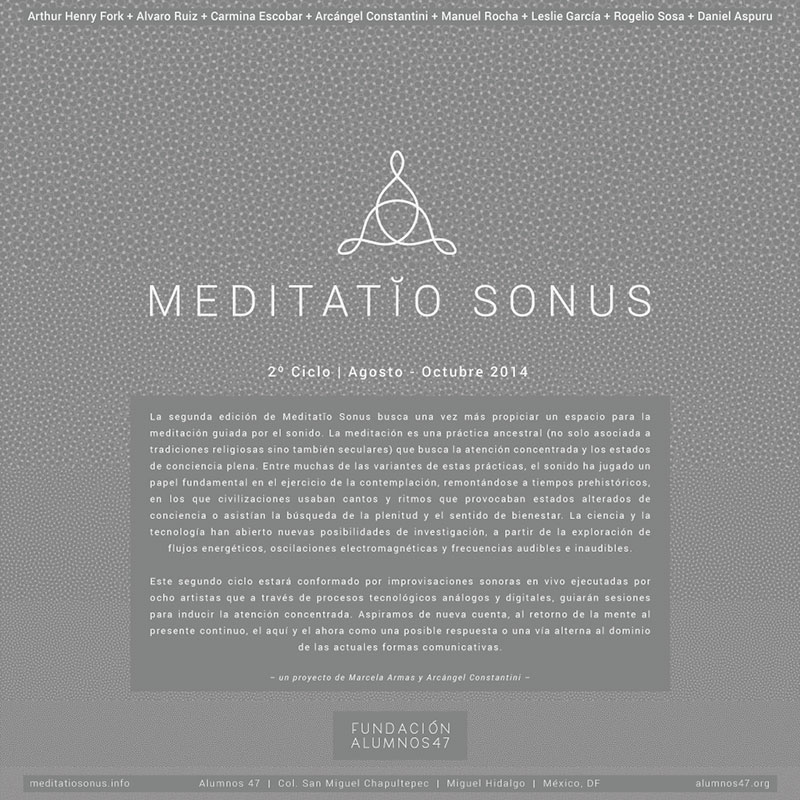

C02 S01 – Arthur Henry Fork
Meditatio Sonus (Mexico City, Cycle I, 2012)
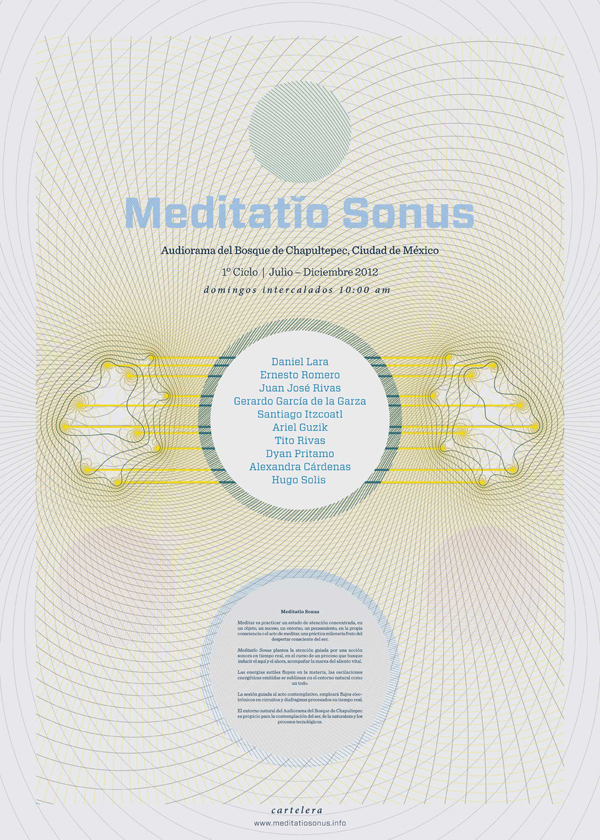
MILPA POLIMERA
Arcángelo Constantini + Marcela Armas.
La semilla de maíz representa un doble origen: para la planta y para el imaginario social mexicano. Es alimento y materia prima de otras sustancias, que van desde los biocombustibles destinados a sustituir a los combustibles fósiles hasta el polímero plástico utilizado en esta pieza.
The corn seed represents a double origin: for the plant and for the Mexican social imaginary. It is food and raw material for other substances, ranging from biofuels intended to replace fossil fuels to the plastic polymer used in this piece.
Por tanto, la naturaleza artificial de la semilla –maíz plástico de maíz- plantea una paradoja de no fácil
solución para la concepción de lo artificial como copia de lo natural. En la semilla están representados tanto lo natural como lo artificial, lo original y lo derivado. La semilla evidencia las tensiones inherentes a estas distinciones. La semilla sembrada por nuestra pieza no es “realmente” una semilla de maíz, aunque tiene su origen (material) en ella.
El maíz se convierte en el origen mítico de varios pueblos precisamente cuando deja de ser completamente natural, para convertirse también en una entidad cultural, un dispositivo que define actividades eminentemente humanas como la agricultura. En algún lugar entre lo natural y lo artificial, el cultivo de maíz domestica tanto al agricultor como al campo de maíz. Pero la agricultura representada en Milpa Polímera también es artificial en un segundo sentido: es agricultura mecanizada. La pieza en sí es un mecanismo biotecnológico.
En su centro, un robot tractor gira en un ciclo cerrado, sembrando la semilla artificial. Las semillas estériles se imprimen y caen al suelo en el espacio radial, convirtiendo el suelo en un campo sembrado, en un artefacto cultural y económico, pero estéril del que nunca crecerá ninguna planta, como su contraparte industrial, un sistema. Atrapada en un ciclo que apunta a establecerse como la única posibilidad. Así presenta la compleja relación entre lo natural y lo artificial, el origen y lo originado, mientras que el suelo se convierte en una representación de lo que no queda, surcado por el mecanismo biotecnológico y sus propios sonidos.
Las semillas impresas están hechas de ácido poliláctico (PLA), un biopolímero termoplástico hecho de maíz. Si bien los defensores argumentan que es biodegradable, en realidad es compostable, ya que se degrada bajo métodos estrictos con un control preciso de la humedad y la temperatura. La verdad es que no hay evidencia de que se desintegre más rápido o más eficientemente que el PET u otros plásticos en un vertedero tradicional. Vale la pena señalar que gran parte del maíz utilizado para producir PLA está modificado genéticamente.
La impresora 3D incluida en el tractor utiliza tecnología open source impulsada por el trabajo colaborativo de una comunidad que busca optimizar sus funciones y compartir códigos y conocimientos. El PLA, por el contrario, es un material patentado con muchas aplicaciones industriales. Al acoplar ambos tipos de tecnología, el tractor fusiona la contradicción entre abierto y cerrado, libre y limitado, y lo presenta en un acto transformador que imita la producción de vida a través de materiales muertos e inertes.
Tradicionalmente en el arte, la naturaleza desempeñaba el papel de modelo original, del que la pieza de arte, epítome de la entidad artificial, era la copia. Giorgio Vasari expresó esta visión del arte de la siguiente manera: “El arte debe su origen a la naturaleza misma … esta hermosa creación, el mundo, nos dio el modelo, mientras que la inteligencia divina fue el maestro original, que nos creó como seres superiores a otros. animales, más como el mismo Dios, si me atrevo a decir ”. En Milpa polímera, en cambio, la naturaleza que sirve de modelo a la obra no es la natura naturans, sino la naturaleza domesticada y su problemática relación con la tecnología. El maíz de Milpa polímera, como el maíz de todos los campos del país, no es el maíz “original”: no es maíz en estado de “pura naturaleza”. Por el contrario, es el maíz actual de campos tecnológicos: menos maíz domesticado que esterilizado por biotecnología de modificación genética.
—
Therefore, the seed’s artificial nature –corn plastic corn- poses a paradox of no easy solution for the conception of the artificial as a copy of the natural. In the seed, both the natural and the artificial are represented, the original and the derivative. The seed evidences the tensions inherent to these distinctions. The seed sown by our piece is not “really” a corn seed, although it has its (material) origin in it.
Corn becomes the mythical origin of several peoples precisely when it ceases to be completely natural, to become also a cultural entity, a device defining eminently human activities such as agriculture. Somewhere between the natural and the artificial, farming maize domesticates both the farmer and the cornfield. But the agriculture represented in Milpa Polímera is also artificial in a second sense: it is mechanized agriculture. The piece itself is a biotechnological mechanism.
At its center, a tractor robot swivels in a closed cycle, sowing the artificial seed. The sterile seeds are printed and fall to the ground on the radial space, turning the soil into a sown field, into a cultural and economic artifact, but a sterile one from which no plant will ever grow, such as its industrial counterpart, a system trapped in a cycle aiming to establish itself as the only possibility. Thus it presents the complex relationship between the natural and the artificial, the origin and the originated, while the soil becomes a representation of what does not remain, furrowed by the biotechnological mechanism and its own sounds.
The seeds printed are made from polylactic acid (PLA), a thermoplastic biopolymer made from corn. While proponents argue that it is biodegradable, actually it is compostable, being degraded under strict methods with precise humidity and temperature control. The truth is there is no evidence that it would disintegrate faster or more efficiently than PET or other plastics in a traditional landfill. It is worth noting that much of the corn used to produce PLA is genetically modified.
The 3D printer included in the tractor uses open-source technology promoted by the collaborative work of a community that seeks to optimize its functions and sharing codes and knowledge. PLA, in contrast, is a patent material with plenty of industrial applications. By coupling both kinds of technology, the tractor blends the contradiction between open and closed, free and limited, and presents it in a transformative act that mimics the production of life through dead and inert materials.
Traditionally in art, nature used to play the role of original model, from which the art piece –epitome of the artificial entity– was the copy. Giorgio Vasari expressed this view of art as follows: “Art owes its origin to Nature herself… this beautiful creation, the world, gave us the model, while the divine intelligence was the original master, which created us as beings superior to other animals, more like God himself –if I dare say”. In Milpa polímera, by contrast, the nature that serves as a model for the work is not the natura naturans, but the domesticated nature and its problematic relationship with technology. The corn of Milpa polímera, such as the corn from all the country’s fields, is not the “original” corn: it is not corn in a state of “pure nature”. On the contrary, it is the current corn from technologized fields: less a domesticated corn than a sterilized one due to biotechnology of genetic modification.
Text: BIOS Ex MachinA
ARTE + CIENCIA
www.artemasciencia.com
ARTE + CIENCIA is a Research and Creating Group under the direction of María Antonia González Valerio. This group brings together the work and collaboration of artists, humanists, scientific / os, exploring inter-and transdisciplinary methods.
The project was originally presented as part of the exhibition SIN ORIGEN based in the University Museum of Contemporary Art and the MUCA Roma in 2012, in Mexico City. SIN ORIGEN was an exhibition curated by María Antonia González Valerio as part of ARTE + CIENCIA program
Recently it was shown in the collective Show “BPLTC III: CONTRÔLE ALIMENTAIRE”, at Eastern Bloc, Montreal
http://easternbloc.ca/expositions
